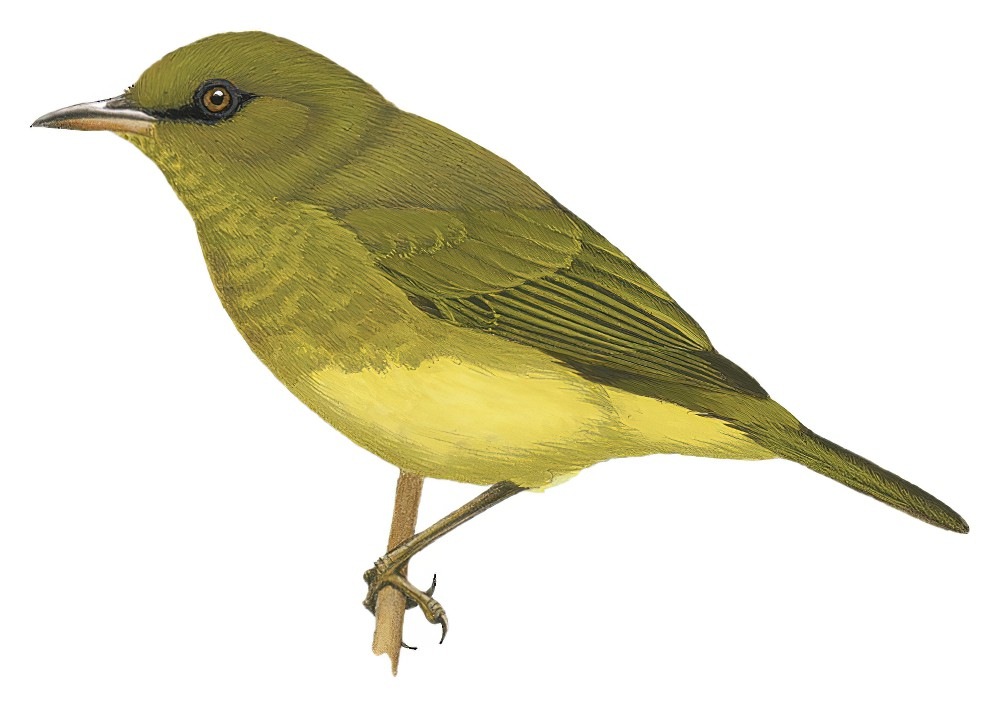Malaita White-eye / Zosterops stresemanni

Malaita White-eye
SCI Name:
Protonym: Zosterops stresemanni Am.Mus.Novit. no.504 p.26
Taxonomy: Passeriformes / Zosteropidae / Zosterops
Taxonomy Code: maweye2
Type Locality: Malaita.
Author: Mayr
Publish Year: 1931
IUCN Status: Least Concern
DEFINITIONS
ZOSTEROPS
(Zosteropidae; Ϯ Madagascar White-eye Z. maderaspatanus) Gr. ζωστηρ zōstēr, ζωστηρος zōstēros belt, girdle; ωψ ōps, ωπος ōpos eye; "Genus. ZOSTEROPS*. Rostrum mediocre, gracile, arcuatum; mandibula superiore vix emarginata; naribus basalibus, linearibus, longitudinalibus, membrana supra tectis, rictu inermi. Alæ mediocres; remigibus prima et quinta fere æqualibus, secunda tertia et quarta paulo longioribus, fere æqualibus, primariis secundarias paululum longitudine superantibus. Pedes subfortes, subelongati; acrotarsiis scutellatis. Cauda æqualis. Caput gracile, concinnum; plumulis periopthalmicis subsericeis albis cingulum subprominentem efformantibus. ... The true Sylvia, if we select the slenderly-formed Warblers of Europe, such as the Motacillæ hippolais, trochilus, &c. Linn., as the types of the genus, are set apart from almost all the other species by the formation of their wing, in which the first quill-feather is extremely short, in some instances, indeed, almost spurious. Of the foreign groups of the family we have already observed that the New Holland genera Malurus and Acanthiza come nearest the European type by the same construction of the wing. The present group essentially differs from it. The first quill-feather is long, almost equal to the second, which together with the third and fourth,—all of them nearly of a length,—are the longest. The nares also are linear and longitudinal, thus differing from the oval form of the European type. In other respects the characters of these two groups have a general accordance. Besides the disposition of the wing-feathers, we may also mention the scutellation of the tarsi, the even tail, and the unarmed rictus, as additional marks of distinction from the before-mentioned New Holland Sylviadæ. From the genus Hylophilus of M. Temminck, which has lately been separated with much judgement from the Sylvia of Dr. Latham, and which also has the first quill-feather elongated and nearly even with the rest, our present group may readily be distinguished by a much more gracile and arcuated bill, in which the nares also are of a different construction. The Motacilla Maderaspatana of Linnæus, (Sylvia Madagascariensis, Lath.), belongs to our group, which seems to have a very wide dispersion. 1. DORSALIS ... Sylvia annulosa, var. β. Swains. Zool. Illust. pl. 16. ... Orbitæ plumulis albis vestitæ. ... *Zωστηρ cingulum, and ωψ oculus." (Vigors & Horsfield 1826); "Zosterops Vigors and Horsfield, 1826, Trans. Linn. Soc. London, 15, p. 234. Type, by subsequent designation (Lesson, 1828 Man. Orn., 1, p. 286), Motacilla maderaspatana Linnaeus." (Mayr in Peters, 1967, XII, p. 290). The majority of white-eyes have a ring of white feathers around each eye.
Var. Fosterops, Fosterzops, Zostenops.
Synon. Cyclopterops, Luteozosterops, Malacirops, Nesozosterops, Oreosterops, Parinia, Sanfordia, Speirops, Tephras, Woodfordia, Zosteropisylvia.
zosterops
Gr. ζωστηρ zōstēr, ζωςτηρος zōstēros belt, girdle; ωψ ōps, ωπος ōpos eye.
stresemanni
Prof. Erwin Friedrich Theodor Stresemann (1889-1972) German ornithologist, explorer, collector (subsp. Accipiter fasciatus, syn. Alisterus chloropterus callopterus, subsp. Aviceda subcristata, syn. Cacomantis variolosus aeruginosus, subsp. Certhia brachydactyla, subsp. Cincloramphus macrurus, subsp. Collocalia esculenta, Cyornis, subsp. Dendrocopos major, syn. Dendropicos fuscescens centralis, subsp. Dicaeum trochileum, subsp. Emberiza schoeniclus, syn. Epimachus fastuosus atratus, syn. Geoffroyus geoffroyi rhodops, subsp. Heleia squamiceps, syn. Hemiprocne comata, syn. Hemispingus melanotis, subsp. Horornis flavolivaceus, Hylexetastes, subsp. Hypsipetes leucocephalus, subsp. Lanius schach, syn. Locustella davidi, subsp. Malia grata, subsp. Melidectes rufocrissalis, subsp. Melilestes megarhynchus, Merulaxis, subsp. Micropsitta pusio, subsp. Mirafra africana, syn. Myiodynastes maculatus, subsp. Nisaetus nanus, subsp. Oriolus chinensis, syn. Otocompsa sinensis, syn. Otus spilocephalus vandewateri, syn. Pachycephala phaionota, subsp. Phylloscopus castaniceps, syn. Picus canus kogo, syn. Pyrrhocorax pyrrhocorax brachypus, syn. Scleroptila levaillantoides, syn. Sericornis nouhuysi pontifex, subsp. Sinosuthora alphonsiana, subsp. Stactolaema whytii, subsp. Todiramphus chloris, subsp. Trichoglossus forsteni, syn. Troglodytes troglodytes cypriotes, subsp. Turdus poliocephalus, Zaratornis, Zavattariornis, Zosterops).
UPPERCASE: current genus
Uppercase first letter: generic synonym
● and ● See: generic homonyms
lowercase: species and subspecies
●: early names, variants, mispellings
‡: extinct
†: type species
Gr.: ancient Greek
L.: Latin
<: derived from
syn: synonym of
/: separates historical and modern geographic names
ex: based on
TL: type locality
OD: original diagnosis (genus) or original description (species)












